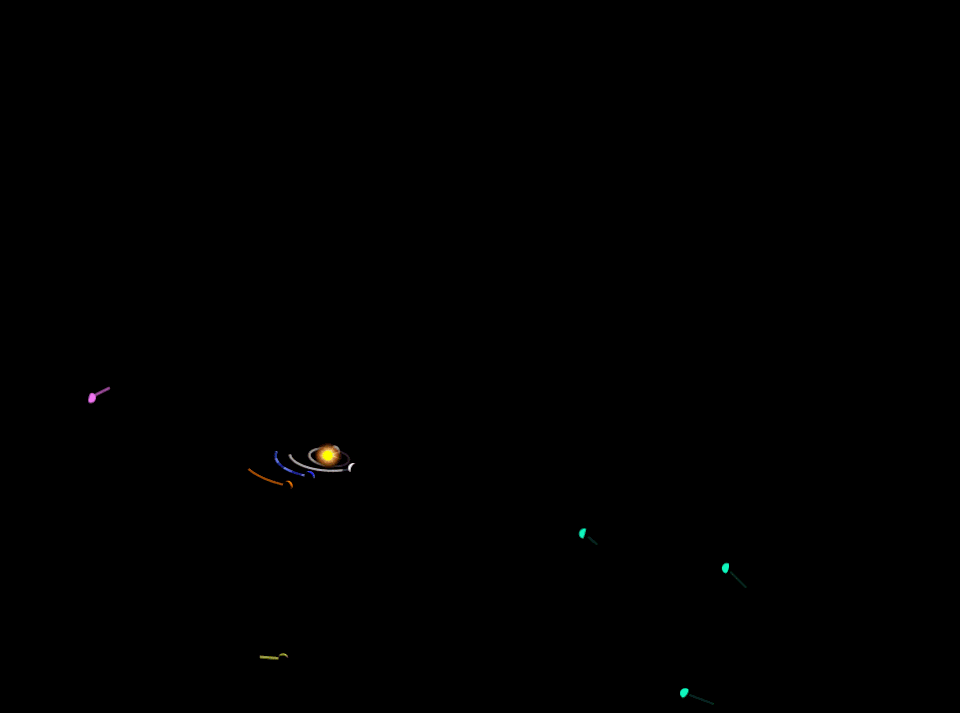 The nominal trajectory of the interstellar asteroid 1I / Oumuamua (aka A / 2017 U1). The calculation is based on observations from October 19, 2017. Notice how the orbits of the planets (rotating fast and in a circle), the Kuiper belt objects (elliptical, almost coplanar) and the orbit of this interstellar asteroid differ.
The nominal trajectory of the interstellar asteroid 1I / Oumuamua (aka A / 2017 U1). The calculation is based on observations from October 19, 2017. Notice how the orbits of the planets (rotating fast and in a circle), the Kuiper belt objects (elliptical, almost coplanar) and the orbit of this interstellar asteroid differ.The correct answer to the question of how the planets move in orbits in our solar system was already given several hundred years ago: first by Kepler, whose laws of motion described them, and then by Newton, whose laws of world wideness were the first to infer. But comets, both originating from the Solar System and flying from a distance, do not move in the same, almost circular, ellipses. Why it happens? Our reader wants to know:
Why comets move around the Sun along parabolic paths, unlike planets moving in elliptical orbits? Where does comet energy come from so far away from the Oort cloud to the Sun and back? And how do interstellar comets and asteroids fly out of their planetary systems and are visited by others?
This question can be answered, but there is a more general question: why do objects move in orbits that way?
 The planets of the Solar system, together with the asteroids from the asteroid belt, move almost in the same plane, in elliptical orbits, close to circular ones. But outside of the orbit of Neptune, everything becomes less reliable.
The planets of the Solar system, together with the asteroids from the asteroid belt, move almost in the same plane, in elliptical orbits, close to circular ones. But outside of the orbit of Neptune, everything becomes less reliable.There are four inner rocky worlds in our solar system, followed by an asteroid belt, gas giants with a bunch of moons and rings, and then
a Kuiper belt . Behind Kuiper's belt there is a huge scattered disk, after which there is a spherical
Oort cloud that extends for a great distance: perhaps one or two light years, almost half the distance to the nearest star.
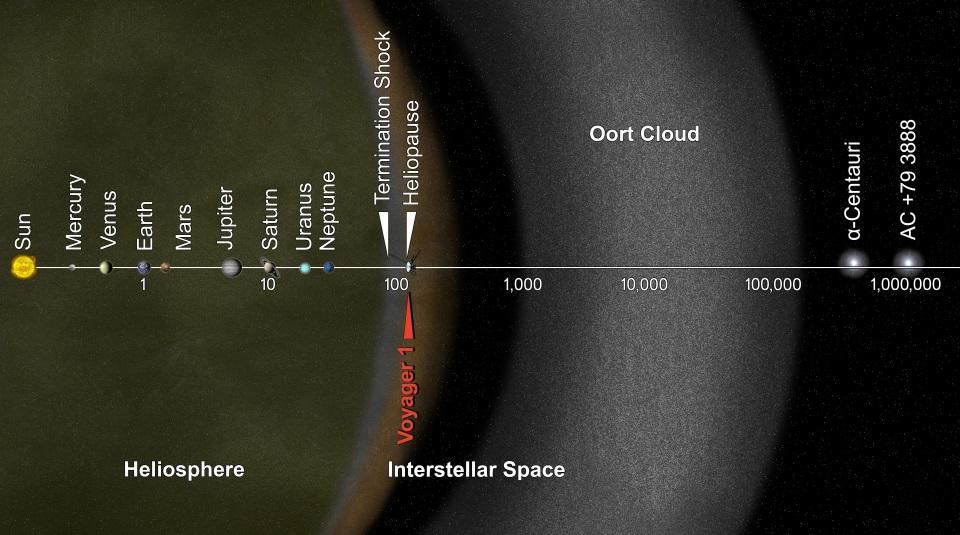 The logarithmic scheme of the solar system, down to the nearest stars, shows the distribution of the Kuiper belt with asteroids and the Oort cloud.
The logarithmic scheme of the solar system, down to the nearest stars, shows the distribution of the Kuiper belt with asteroids and the Oort cloud.In accordance with the laws of gravity, to be in a stable orbit of a certain size, an object must move at a certain speed. There must be a balance between the potential energy of the system (in the form of gravitational potential energy) and the energy of motion (kinetic). The deeper you are in the potential gravitational well of the Sun (that is, the closer you are to it), the less energy you have and the faster you need to move to maintain a stable orbit.
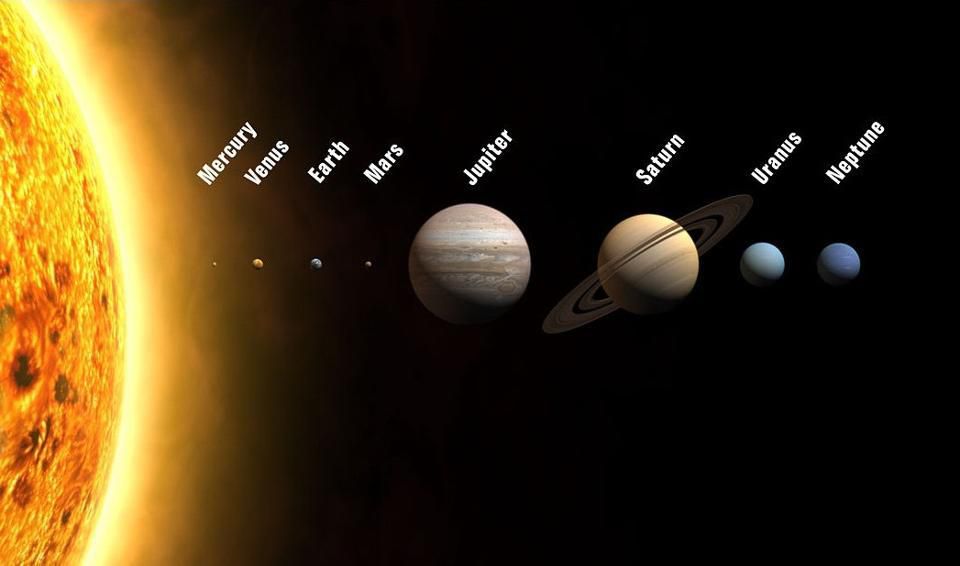 The eight planets of the solar system and the sun, on a scale of size, but not on a scale of orbital diameters. Of all the planets visible to the naked eye, Mercury is the hardest to see.
The eight planets of the solar system and the sun, on a scale of size, but not on a scale of orbital diameters. Of all the planets visible to the naked eye, Mercury is the hardest to see.Therefore, the average speed of the planets is:
- Mercury: 48 km / s,
- Venus: 35 km / s,
- Earth: 30 km / s,
- Mars: 24 km / s,
- Jupiter: 13 km / s,
- Saturn: 9.7 km / s,
- Uranus: 6.8 km / s,
- Neptune: 5.4 km / s.
Thanks to the environment in which the solar system was formed — a multitude of small masses that merged together, interacted with each other, produced a multitude of mass emissions — the current situation is rather close to circular.
 The orbits of the planets of the inner solar system are not entirely circular, but close enough to this. Mercury and Mars deviate the most from the ideal. In addition, the closer the planet is to the Sun, the faster it needs to move.
The orbits of the planets of the inner solar system are not entirely circular, but close enough to this. Mercury and Mars deviate the most from the ideal. In addition, the closer the planet is to the Sun, the faster it needs to move.But it is necessary to take into account the gravitational interaction that occurs later! If an asteroid or a Kuiper belt object passes near a large mass like Jupiter or Neptune, the gravitational interaction can give it a good kick. This will significantly change its speed, adding a few km / s in almost any direction. And in the case of an asteroid, this may mean changing the orbit from almost circular to very elliptical; A good example of such a case is the path of
comet Enke , which could have come from the asteroid belt.
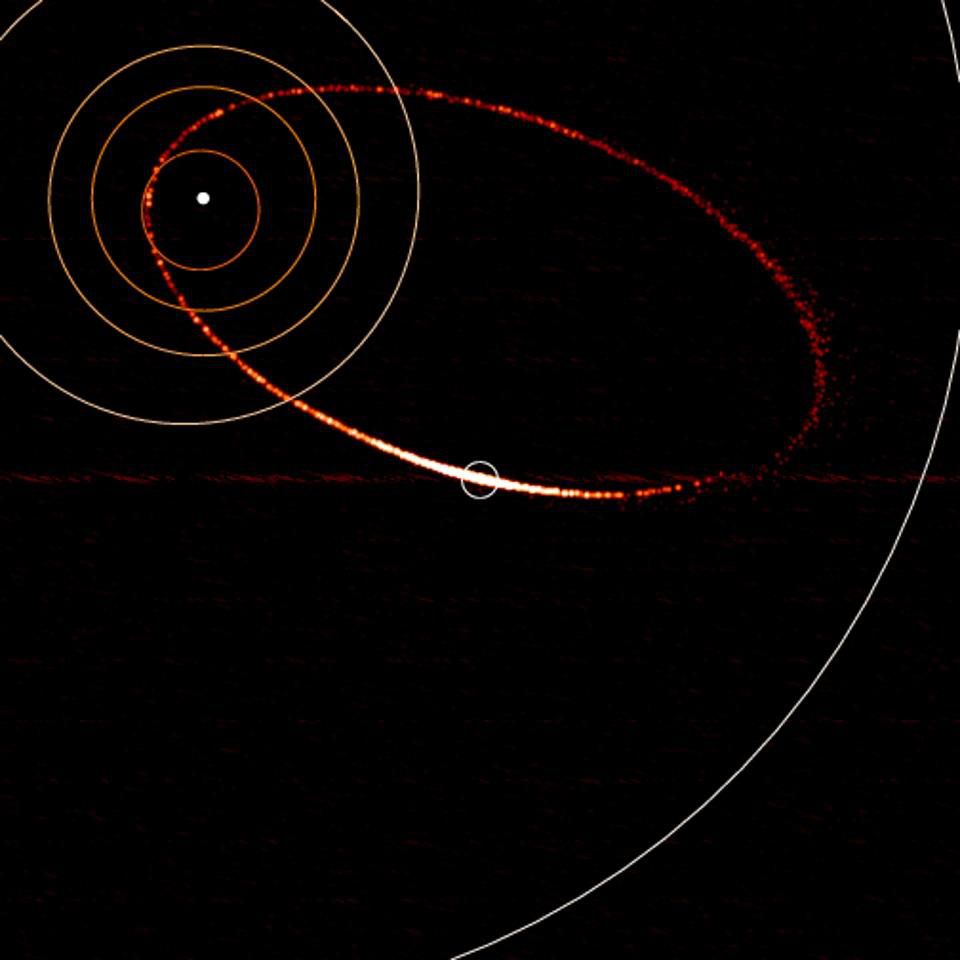 The trail of Enke's comet, making a complete revolution in 3.3 years, is an extremely fast motion, distributed over an eccentric ellipse. Enke was the second periodic comet found after Halley's comet.
The trail of Enke's comet, making a complete revolution in 3.3 years, is an extremely fast motion, distributed over an eccentric ellipse. Enke was the second periodic comet found after Halley's comet.On the other hand, if you are very far away, for example, in the Kuiper belt or in the Oort cloud, we are able to move at speeds from 4 km / s (the inside of the Kuiper belt) to several hundred meters per second (for the Oort cloud). Gravitational interaction with a large planet like Neptune can change your orbit in one of two ways. If Neptune takes energy from you, you are thrown into the inner solar system, and an ellipse with a long period appears, similar to the path of
comet Swift - Tattle , the one that created the meteor shower Perseids. This may be an ellipse barely gravitationally associated with the sun, but still an ellipse.
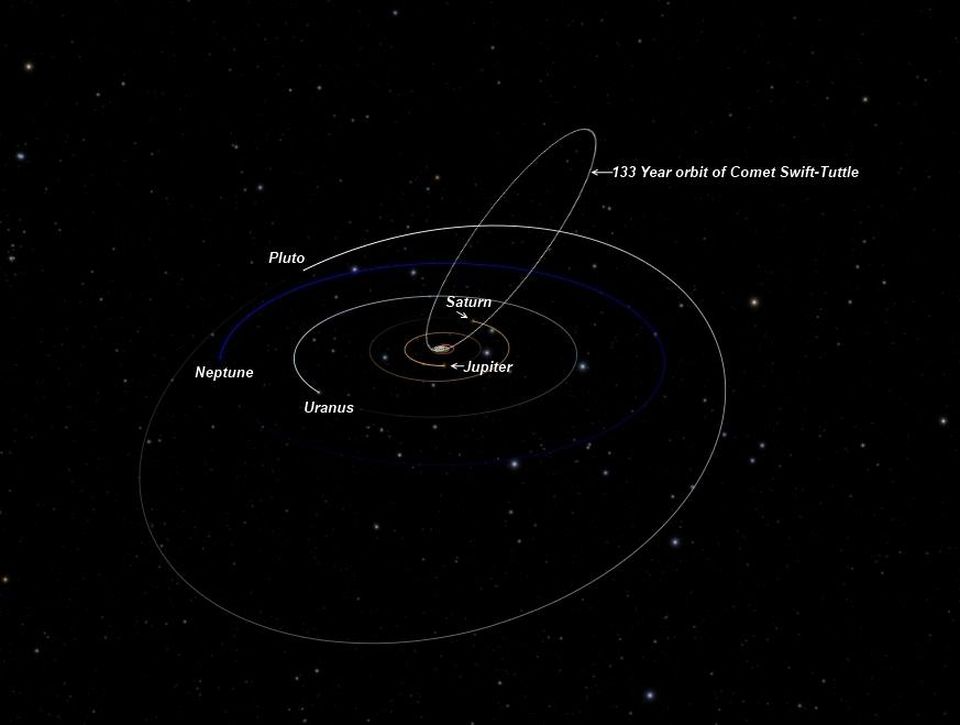 The orbit of Comet Swift-Tuttle, passing dangerously close to the Earth’s path around the Sun, is extremely elliptical compared to any planetary orbit. It is assumed that long ago, its orbit was affected by gravitational interaction either with Neptune or with another massive object, and as a result we got what we have today.
The orbit of Comet Swift-Tuttle, passing dangerously close to the Earth’s path around the Sun, is extremely elliptical compared to any planetary orbit. It is assumed that long ago, its orbit was affected by gravitational interaction either with Neptune or with another massive object, and as a result we got what we have today.But if Neptune or any other body (we still do not know what is on the edge of the Solar System) gives you additional kinetic energy, it can change your orbit from gravitationally connected elliptical to non-adherent hyperbolic. (A parabolic orbit is an unbound orbit just on the border between elliptic and hyperbolic). If anyone remembers the
comet ISON , which was moving close to the Sun from 2013, and which disintegrated as it approached the star, then it was in a hyperbolic orbit. Usually comets that come from the far ends of the solar system lack several kilometers per second to the border between bound and unbound orbits.
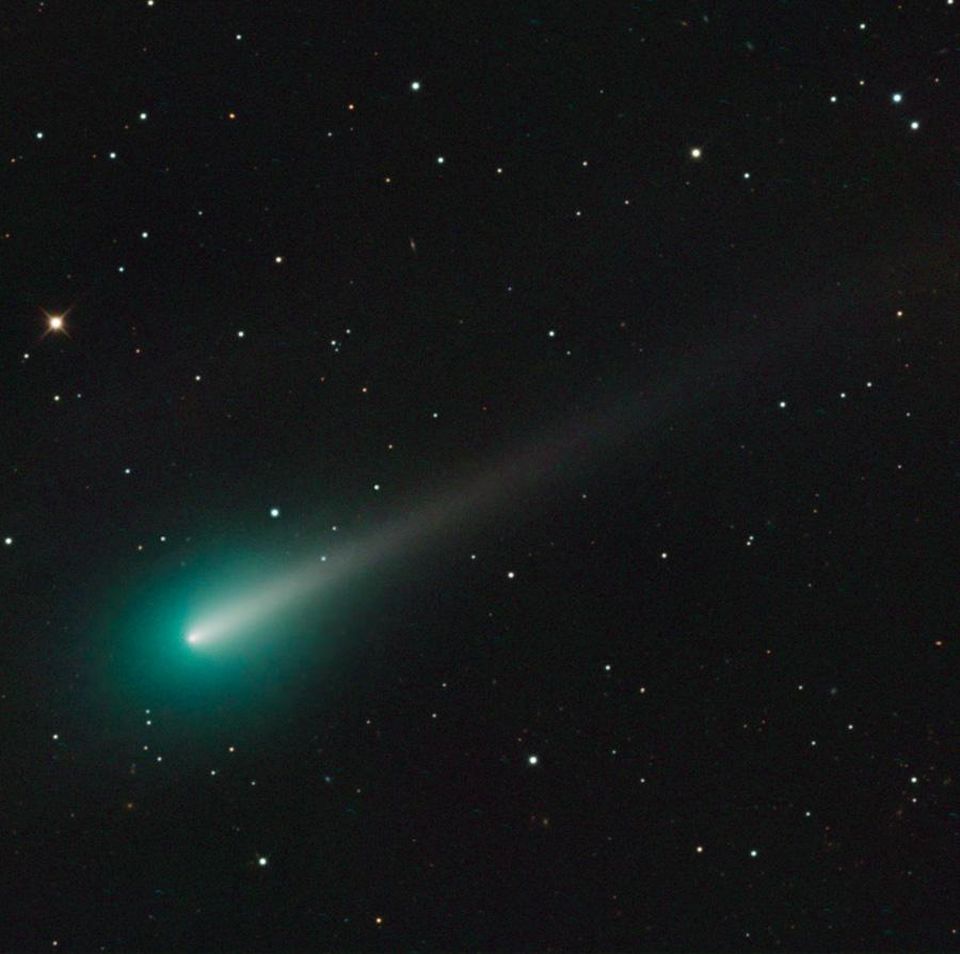 Comet ISON, having entered the Solar System, acquired tails directed away from the Sun. She "hurt" the Sun, having passed at a distance of only 2 million km, and later because of such proximity broke up.
Comet ISON, having entered the Solar System, acquired tails directed away from the Sun. She "hurt" the Sun, having passed at a distance of only 2 million km, and later because of such proximity broke up.The strangest fact, seemingly counterintuitive for most people, is that comets do not need a lot of energy to break into the inner part of the solar system! If you take an object, even if it is in the light year from the Sun, and just let it go, then for quite a long time it will just fall on the Sun. A very small change in the velocity vector of distant masses moving in an orbit around the solar system can push them closer. Such gravitational poking happens randomly, but we see only those objects that began to move faster, come closer to the Sun, have developed “tails” and become bright enough so that they can be seen. So comets appear.
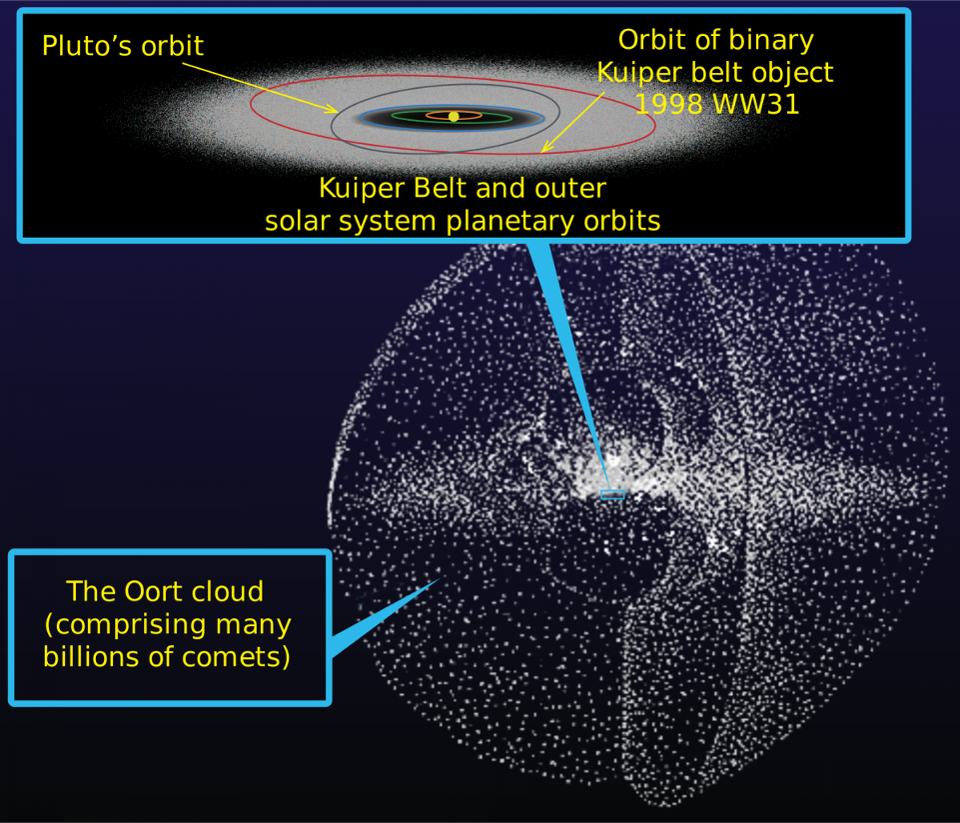 The Kuiper belt is the location of a huge number of known objects in the solar system, but in the Oort cloud, which is dimmer and much farther away, there are much more objects, and more likely to be shot down from a normal orbit by a mass passing by, for example, another star. The speed of motion of the Kuiper belt objects and the Oort cloud relative to the Sun is very small.
The Kuiper belt is the location of a huge number of known objects in the solar system, but in the Oort cloud, which is dimmer and much farther away, there are much more objects, and more likely to be shot down from a normal orbit by a mass passing by, for example, another star. The speed of motion of the Kuiper belt objects and the Oort cloud relative to the Sun is very small.Most of them are either barely connected, or slightly not connected gravitationally, therefore A / 2017 U1 has become such an amazing discovery. Unlike ordinary comets and asteroids, it was very strongly unbound gravitationally. And if objects from the edges of the Solar System move at speeds of no more than a few km / s, then this object moved at a speed of more than 40 km / s. He must have come not from the Solar System, since even Neptune would not have enough mass to give him such an acceleration!
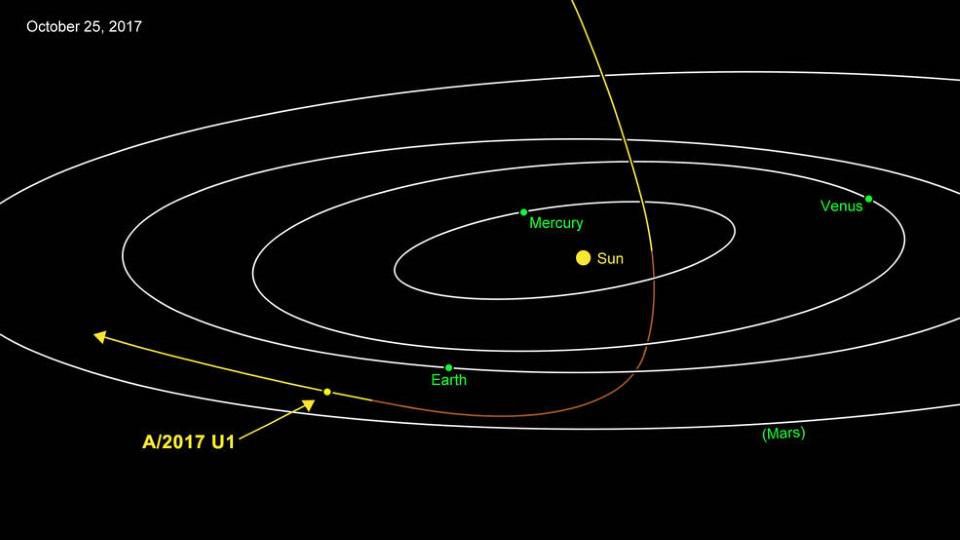 A / 2017 U1 likely comes from interstellar space. He came closest to the Sun on September 9th. Moving at a speed of 44 km / s, the comet is directed away from the Earth and the Sun, beyond the limits of the Solar System.
A / 2017 U1 likely comes from interstellar space. He came closest to the Sun on September 9th. Moving at a speed of 44 km / s, the comet is directed away from the Earth and the Sun, beyond the limits of the Solar System.What causes a comet, an asteroid, another object outside the solar system to move to a similar orbit? Just gravity, and all the gravitational interactions that occurred during its existence. Objects of the Solar System move in elliptical orbits around the Sun. But gravitational interactions can change this, either by changing the shape of the ellipse, or turning it into an unbound gravitational hyperbola. In any case, we will see such an object, if only it is thrown close to the Sun - only in this way could we learn about the existence of all the comets discovered by us.
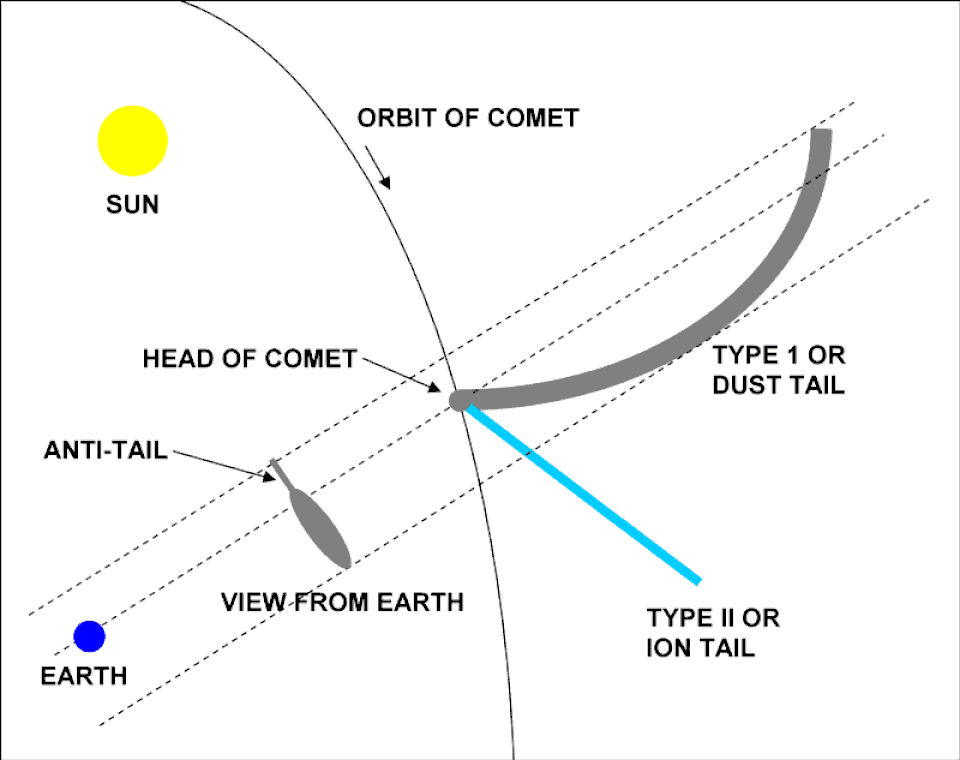 The tails of comets do not repeat the trajectory of motion exactly, but are directed along a straight or curved path directed from the Sun, depending on whether it is blown off from an object — ions or dust particles. In any case, comets — their tails, comas , what reflects light — are visible to us only when they are close enough to the Sun.
The tails of comets do not repeat the trajectory of motion exactly, but are directed along a straight or curved path directed from the Sun, depending on whether it is blown off from an object — ions or dust particles. In any case, comets — their tails, comas , what reflects light — are visible to us only when they are close enough to the Sun.Comets and asteroids, which are thrown out of the solar system, fly through interstellar space, and someday they will pass by other stars. Since the relative speed of the stars in the galaxy is of the order of 10-30 km / s, these interstellar stones will move in such a way that explains why the interstellar asteroid that we discovered has moved so fast. Everything is explained by the combination of the initial orbit, gravitational interactions and the movement of our solar system through the galaxy. By taking energy from an object from the asteroid belt, the Kuiper belt, or the Oort cloud, you create an ellipse that is more attached to the sun. When you give the object an energy acceleration, it can be thrown out.
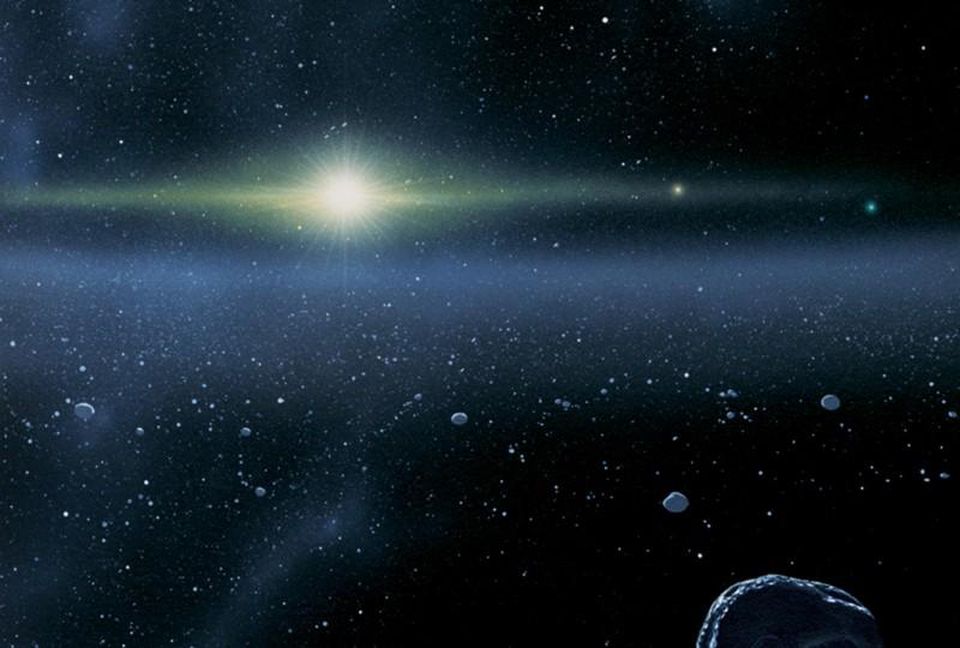 Now we believe that we understand how the Sun and the Solar System was formed, and this view is an illustration of the early stages of formation. Today we have only those objects that survived in this process.
Now we believe that we understand how the Sun and the Solar System was formed, and this view is an illustration of the early stages of formation. Today we have only those objects that survived in this process.What conclusion can be drawn from this? Over time, fewer objects remain in our solar system, and the number of objects in the asteroid belt, the Kuiper belt and the Oort cloud decreases all the time. Over time, these formations become increasingly sparse. Who knows how many objects were there once? It is impossible to count them. In the solar system, only survivors remain available to us.